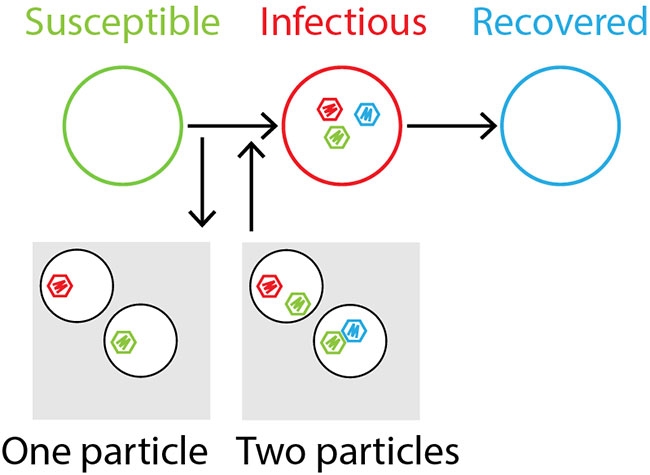Why multipartite viruses infect plants rather than animals
Published: October 1, 2019
Being in between living and non-living, viruses are, in general, strange. Among viruses, multipartite viruses are among the most peculiar—their genome is not packed into one, but many, particles. Multipartite viruses primarily infect plants rather than animals. A recent paper by researchers from Tokyo Institute of Technology (Tokyo Tech) uses mathematical and computational models to explain this observation.
Multipartite viruses have a strange lifestyle. Their genome is split up into different viral particles that, in principle, propagate independently. Completing the replication cycle, however, requires the full genome such that a persistent infection of a host requires the concurrent presence of all types of particles (see Fig. 1). The origin of multipartite viruses is an evolutionary puzzle. Apart from the why they can have such a costly lifestyle, the most peculiar thing about them is that almost all known multipartite viruses infect either plants or fungi—very few viral species infects animals.
So far, most theoretical research has been trying focusing on explaining how it is viable to have the genome split into different particles. This paper provides a theoretical explanation why multipartite viruses primarily infect plants.
There has been great efforts to understand the mechanisms that give multipartite viruses an advantage that can compensates for their peculiar and costly lifestyle, and this is not yet a solved problem. In addition, our understanding of why most multipartite viruses infect only plants is limited. In a recent work, published in Physical Review Letters, Petter Holme of the World Research Hub Initiative, Tokyo Tech and colleagues from China and the USA, have explained why multipartite viruses primarily infect plants. In their work, the authors formulated a minimal network-epidemiological model.
They used mathematical models and computer simulations to show that multipartite viruses colonize structured population (representing the interaction patterns among plants) with less resistance, compared to a well-mixed population (representing the interaction patterns among animals). This is thus an explanation why multipartite viruses infect plants rather than animals.
The researchers from Tokyo Tech continue to investigate the epidemiology of different types of infectious diseases by theoretical methods. At the moment, they are interested in more common disease spreading scenarios such as how influenza spreads in cities and how that could be mitigated.

Figure 1. The Susceptible-Infectious-Recovered model to understand multipartite viruses.
Many infectious diseases are modeled by the Susceptible-Infectious-Recovered model. In this model, when a susceptible individual (someone who don't have the disease) meets an infectious individual (someone who have the disease and can spread it), the susceptible can become infectious. After some time the infectious can become recovered (someone who don't have the disease and can't get it). This model has to be modified so that the infection step (when susceptible becomes infectious) describes the accumulation of virus particles until the individual has a complete viral genome.
Reference
Authors : |
Yi-Jiao ZhangM1, Zhi-Xi Wu1, Petter Holme2*, Kai-Cheng Yang3 |
Title of original paper : |
Advantage of Being Multicomponent and Spatial: Multipartite Viruses Colonize Structured Populations with Lower Thresholds |
Journal : |
Physical Review Letters |
DOI : |
|
Affiliations : |
1 Institute of Computational Physics and Complex Systems, Lanzhou University
2 Tokyo Tech World Research Hub Initiative (WRHI), Institute of Innovative Research, Tokyo Institute of Technology
3 School of Informatics, Computing, and Engineering, Indiana University
|
Corresponding author's email: holme@cns.pi.titech.ac.jp
. Any information published on this site will be valid in relation to Science Tokyo.



